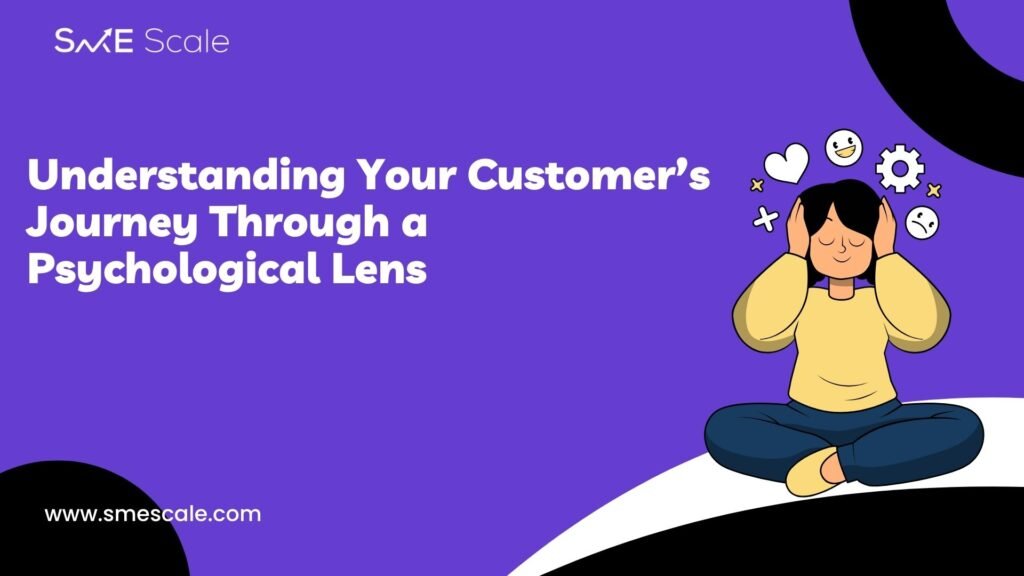
How SMEs Can Use Behavioral Insights to Drive Sustainable Growth
At SME Scale, we believe that real growth doesn’t come from chasing trends—it comes from deeply understanding your customer. One of the most overlooked (yet powerful) tools in an SME’s scaling strategy is psychology—specifically, using it to map and optimize the customer journey.
When you combine structured sales systems with psychological insights, you create a growth engine that not only increases revenue but builds long-term trust and loyalty.
In this post, we’ll walk through the customer journey through a psychological lens, show you how to apply it practically, and share a real-world case study from a growing SME that used this approach to increase conversions by over 60%.
🧠 Why Psychology Matters in the Customer Journey
The customer journey is the path a potential buyer takes—from first awareness to purchase and beyond. But here’s the catch: most SMEs design their funnel based on what they want customers to do—not what customers actually think or feel.
By understanding key psychological triggers at each stage, you can:
Anticipate objections before they surface
Reduce friction and increase trust
Craft messages that resonate emotionally
Convert more leads into long-term customers
At SME Scale, we integrate these principles into the Sales Scale System™—a consultative, psychology-informed sales framework designed specifically for SMEs.
🔍 The 5 Psychological Stages of the Customer Journey
1. Awareness – Curiosity & Pattern Recognition
Customers aren’t looking for your business—they’re scanning for something familiar, relevant, and safe.
Psychological Insight:
People are hardwired to notice things that align with their existing beliefs or recent experiences (aka the Baader-Meinhof phenomenon).
Tactic:
Use targeted content that reflects your audience’s daily language, problems, and goals. Avoid corporate jargon.
2. Interest – Emotional Anchoring
Once a customer’s attention is caught, they want to know: “Is this worth my time?”
Psychological Insight:
The availability heuristic makes people overvalue what’s emotionally charged and easy to remember.
Tactic:
Craft emotionally compelling headlines and stories. Use testimonials and imagery that trigger connection.
3. Consideration – Trust & Loss Aversion
At this point, they’re comparing options—but fear kicks in: “What if I choose wrong?”
Psychological Insight:
Loss aversion is powerful here. People fear making bad choices more than missing out on the best ones.
Tactic:
Provide clarity through side-by-side comparisons, social proof, and risk reversals (free trials, guarantees, etc.).
4. Decision – Choice Simplification
Too many options or too much information? Paralysis.
Psychological Insight:
The paradox of choice causes decision fatigue—too many good options leads to no action.
Tactic:
Offer one clear call to action. Use urgency honestly: “Only 3 consultation slots left this month.”
5. Post-Purchase – Consistency & Identity Reinforcement
After buying, your customer wants to feel good about their decision. This is where loyalty is either built or broken.
Psychological Insight:
People seek consistency with their identity. If your product reinforces their self-image, they’ll stick around.
Tactic:
Send onboarding emails that affirm their smart choice. Highlight client success stories they can relate to.
📈 Real-Life Case Study: The Growth of “GrowTech Solutions”
Client: GrowTech Solutions (B2B SaaS platform for agriculture management)
Challenge: High website traffic, low demo conversions
Goal: Increase quality leads and reduce bounce rate
SME Scale Approach:
We mapped out GrowTech’s customer journey using our Sales Scale System™ with psychological insights baked in.
Phase 1: Reframed the Awareness Message
Old: “Advanced farm analytics software for your agribusiness.”
New: “Tired of losing yield to unpredictable weather? Here’s how smart farms stay ahead.”
✅ Result: Bounce rate dropped by 26%.
Phase 2: Added Emotion to Consideration Stage
We embedded testimonials from clients who regretted waiting too long.
“We thought we could manage without it—until we lost 20% of our crop to misplanning. GrowTech saved our next season.”
✅ Result: 63% increase in demo bookings.
Phase 3: Simplified the Decision Funnel
Reduced options from 4 packages to 2 with guided recommendations
Added 14-day free trial with a “no credit card” policy
✅ Result: Conversion rate doubled from 12% to 25%.
🛠 How to Apply This to Your SME
Whether you’re in consulting, SaaS, eCommerce, or services, you can use these psychological tactics to improve your customer journey:
Stage Tactic Psychological Trigger
Awareness Targeted headlines & pain points Pattern recognition, relevance
Interest Storytelling & visuals Emotional anchoring
Consideration Risk reversal & testimonials Loss aversion, social proof
Decision One CTA & clear choices Choice simplification
Loyalty Onboarding & identity affirmations Consistency bias
🚀 Final Word: Systems That Think Like Your Customer
Most SMEs hit growth plateaus because they treat customers like data points instead of humans with fears, hopes, and habits.
At SME Scale, we help SMEs implement systems that scale sustainably by aligning with buyer psychology. When your funnel reflects how your customer actually thinks, it performs better—consistently.
👉 Ready to map your customer journey with a psychology-first approach?
Book a strategy call today and let’s create a system that thinks like your buyer—so you don’t have to guess.


